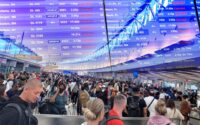Does your hotel or Airbnb come with a hidden camera?
Do the Bs in Airbnb stand for Big Brother?
For better or worse, home-rental services have revolutionized the way we travel. But expanded lodging options have meant that more travelers could fall prey to common criminal hustles — stemming from the fact that ordinary (and some deviant) people are opening up their homes to travelers.
At the same time, surveillance technology has become increasingly accessible to anyone — and now designed to be stealthier than ever.
It’s a phenomenon once presumed to be a problem only for guests at seedy roadside motels, but users on the room-sharing platform have reported bizarre and frightening instances of discovering a hidden camera in their short-term rental.

While some owners claim it’s for their own protection — against potential theft and destruction of property — experts warn against the disturbing practice as one’s home allows for countless undercover methods to spy on their guests.
TikTok user Marcus Hutchins, an “ex-hacker” who teaches cybersecurity, shared a few tips with his followers on how to spot hidden cameras, in a recent video with more than 33.4 million views.
“The first [places] you’re going to want to look for is devices that are conveniently placed where a creeper would want to look,” he says.

“One way to see if a device is a camera is to shine a bright light at it. If you hit a camera lens, it’s going to give a bluish reflection,” says Hutchins. You can see an example of the type of bluish reflection by shining a flashlight at a smart phone camera.
Seemingly innocuous devices such as fire alarms and alarm clocks can double as cameras, Hutchins demonstrates. In his video, a light shown on a mirrored clock face revealed a tiny camera lens behind the screen on one side of the digital counter. “If we shine a bright light at it, we can shine through the glass, and see there’s a camera there. Now, this technique can also work on two-way mirrors.”

Even wall chargers for unrelated devices can serve as cameras, as with Hutchins’ example of a USB-powered camera-clock with a tiny lens embedded in its power source. “If we shine the light on it, you can see that little pinhole in the middle with the blue reflection — that is the camera lens.”
To spot cameras with night-vision capabilities, Hutchins says to look out for infrared LED lights on the device which are needed for the camera lens to see at night. While they can be difficult to find with the naked eye, peering through your iPhone camera may reveal the LEDs more readily.

“If we turn off the lights and use the front-facing phone camera, we can actually see these LEDs,” says Hutchins. He also warned the back-facing camera won’t work due to its built-in red-eye filter.
“These camera lenses are very small … they can be hidden in anything, even a hole in the wall,” Hutchins adds at the end of his public advisory. “Check any suspicious devices or holes that are facing the shower, dressing area or bed.”
It may seem overly cautious, but it’s a real, documented issue as Twitter user Jason Scott and his friend learned in 2017.
“A colleague of mine thought it odd that there was a single ‘motion detector’ in his AirBnb in the bedroom,” tweeted Scott. “And voila, it’s an IP camera connected to the web.” The friend, he added, “left at 3am” and reported the incident. The host was reportedly “suspended” and the “colleague got [a] refund.”
The Independent spoke to Keith Roberts, a technician with UK-based surveillance-detector service Advanced Sweeping, about how to spot hidden cameras wherever they are.
“Cameras and eavesdropping devices are much more prevalent these days,” Roberts told the newspaper. “There used to be a select market, and you had to know someone to get hold of one. They’re much easier to purchase now — anyone can buy them off the shelf from Amazon or eBay.”
Echoing Hutchins’ advice, Roberts also said to keep eyes peeled for “tiny holes” with unobstructed views, especially in “common” hiding spots such as books, mirrors, light bulbs, stuffed animals or house plants.
Regarding Hutchins’ flashlight method, Roberts agreed: “You can look for a lens with a torch [flashlight] and it’s 92% to 95% accurate.”
“Look in logical places; if someone was looking for information, they’d put a device in the lounge. If the person was a voyeur, they’d likely put a camera in the dressing down areas like the bathroom, shower room and bedroom,” he said.
Look out for two-way mirrors, too, with a “fingernail test.” If your finger can touch itself in the mirror, that’s a good indication it is doubling as a window. In a standard mirror, there will be a gap between your finger and the reflection. However, be advised that this method isn’t foolproof, and some mirrors with hidden cameras may appear to function as any other.
The Post reached out to Airbnb to discuss its policy on the use of household surveillance in its listings.
While hidden cameras of any type or location are “banned,” Airbnb hosts are allowed to have cameras around the house exterior, as well as in a common indoor space, such as a living room — but only if it’s clearly stated and identified to guests.


